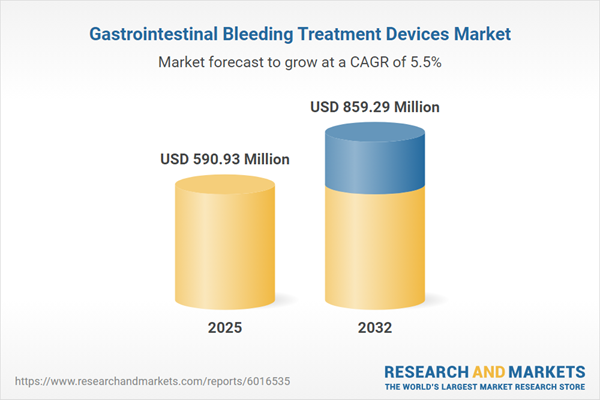Speak directly to the analyst to clarify any post sales queries you may have.
The gastrointestinal bleeding treatment devices market is rapidly evolving as healthcare organizations embrace next-generation technologies, data-driven platforms, and more dynamic regulatory standards. This drives significant changes in purchasing, technology integration, and patient management—factors that matter to leaders overseeing strategic decisions and procurement in the clinical device sector.
Gastrointestinal Bleeding Treatment Devices Market Snapshot
The gastrointestinal bleeding treatment devices market grew from USD 559.43 million in 2024 to USD 590.93 million in 2025 and is projected to reach USD 859.29 million by 2032, reflecting a CAGR of 5.51%.
The primary drivers include demand for minimally invasive solutions, rising adoption of digital platforms, and broader clinical utilization. New regulatory measures and more favorable reimbursement policies are encouraging product advancement, enabling better device adoption and reliable market expansion.Scope & Segmentation of the Gastrointestinal Bleeding Treatment Devices Market
- Product Types: Endoscopic clips deliver mechanical hemostasis, while various hemostatic agents—including powders, sheets, and sprays—provide tailored support for bleeding control. Injection therapies such as alcohol sclerosant, epinephrine, and polidocanol offer chemical alternatives for intervention. Thermal technologies—ranging from argon plasma coagulation to bipolar and heater probes—ensure targeted energy-based treatments.
- Technology: The segment comprises flexible and rigid endoscopic systems, radiological approaches like angiographic embolization and mesenteric stenting, and both laparoscopic and conventional surgical methods, reflecting differing needs for clinical complexity and intervention.
- Application Areas: Devices are implemented in cases of angiodysplasia, Dieulafoy lesion, Mallory-Weiss tear, peptic ulcers, and variceal bleeding. Each application requires customizable procedural techniques and adaptable device design.
- End Users: Deployment environments include ambulatory surgical centers, gastroenterology clinics, and inpatient as well as outpatient hospital settings. Distinct procurement cycles and workflow preferences inform technology selection in each domain.
- Indication Type: Solutions cover both lower (colonic and rectal) and upper (duodenal, esophageal, gastric) gastrointestinal bleeding, ensuring compatibility with anatomical and varying clinical severity requirements.
- Regions Covered: The market analysis spans North and Latin America, Europe, Middle East & Africa, and Asia-Pacific. Notably, China, India, and Japan lead adoption, influenced by localized clinical imperatives and diverse device preferences.
- Companies Analyzed: Competitive profiling includes Boston Scientific Corporation, Medtronic plc, Olympus Corporation, FUJIFILM Holdings, HOYA Corporation, Cook Medical, Johnson & Johnson, B. Braun Melsungen AG, Teleflex Incorporated, and ConMed Corporation, all reflecting sectoral innovation and a broad product range.
Key Takeaways for Senior Stakeholders
- Collaboration between engineering, clinical, and compliance teams accelerates development of improved hemostatic materials and digital delivery solutions, establishing updated care protocols and influencing value-based models.
- Minimally invasive devices and ongoing miniaturization shift treatment to outpatient procedures, deliver higher lesion-targeting precision, and boost operational efficiency.
- Artificial intelligence and digital imaging tools are advancing diagnostic confidence, supporting more informed intraoperative decisions and expanding device adoption for challenging cases.
- Procurement increasingly focuses on reimbursement reforms and outcome measurement, guiding long-term supplier partnerships and evaluation metrics.
- Strengthening collaboration between radiology and endoscopy initiates demand for hybrid devices, enhancing the capacity to manage diverse, complex bleeding events.
- Adaptive supply chain models—centered on localization and diversified sourcing—support resilience in response to regulatory changes and global distribution challenges.
Tariff Impact on Supply Chain and Cost Structures
The 2025 introduction of new US tariffs on select medical device components is influencing cost structures for gastrointestinal bleeding treatment device suppliers. Companies are shifting toward localized production, dual sourcing, and updated supplier agreements to maintain profitability and robust operations. Healthcare purchasers are placing a greater emphasis on supplier dependability and supply chain integrity, adjusting procurement standards to reinforce strategic planning in a volatile market scenario.
Research Methodology & Data Sources
Insights in this report result from structured interviews with clinical and procurement leaders, combined with secondary review of peer-reviewed literature, regulatory publications, and certified industry datasets. Cross-analysis with market participants validates findings to address the information needs of executive stakeholders.
Why This Report Matters
- Empowers decision-makers to anticipate key trends, manage regulatory risks, and adapt investment strategies related to gastrointestinal bleeding treatment devices.
- Delineates current developments in device segmentation, clinical application, and operational shifts arising from new reimbursement and oversight guidelines.
- Supports organizations in aligning R&D, logistics, and commercialization plans for sustainable performance within evolving global regulatory frameworks.
Conclusion
Continuous product innovation and adaptive supply strategies shape this market, allowing organizations to address changing clinical demands and regulatory expectations confidently.
Additional Product Information:
- Purchase of this report includes 1 year online access with quarterly updates.
- This report can be updated on request. Please contact our Customer Experience team using the Ask a Question widget on our website.
Table of Contents
3. Executive Summary
4. Market Overview
7. Cumulative Impact of Artificial Intelligence 2025
Companies Mentioned
The companies profiled in this Gastrointestinal Bleeding Treatment Devices market report include:- Boston Scientific Corporation
- Medtronic PLC
- Olympus Corporation
- FUJIFILM Holdings Corporation
- HOYA Corporation
- Cook Medical LLC
- Johnson & Johnson
- B. Braun Melsungen AG
- Teleflex Incorporated
- ConMed Corporation
Table Information
| Report Attribute | Details |
|---|---|
| No. of Pages | 196 |
| Published | November 2025 |
| Forecast Period | 2025 - 2032 |
| Estimated Market Value ( USD | $ 590.93 Million |
| Forecasted Market Value ( USD | $ 859.29 Million |
| Compound Annual Growth Rate | 5.5% |
| Regions Covered | Global |
| No. of Companies Mentioned | 11 |









